Tag: Alexandra Huzyk ’20
Wherefore Art Thou, Scorsese?: Humanities Forum Warns of “Absent History”
by The Cowl Editor on March 5, 2020
Campus

by Alexandra Huzyk ’20
News Staff
In this past week’s Humanities Forum, Dr. Brian Walsh spoke on “Shakespeare and the Performance of History.” Walsh, a senior lecturer in the arts and sciences writing program at Boston University, is an expert in adaptations of Shakespeare in film, modern drama, and contemporary drama.
The lecture was meant to compliment the Development of Western Civilization program and was the second of three events to be connected to Shakespeare.
Walsh began the lecture by pointing out that modern consumption of Shakespearean drama is largely by studying plays through print. Even if we do see it, it is often a movie or a recording and not an authentic play.
He stated, “Plays don’t tell us how they were performed, just how they were printed.” By only studying the print itself, one loses both the experience of watching a production and the theatrical context that is meant to enhance the storyline.
Walsh emphasized that Shakespeare’s pieces were live events to which Elizabethan audiences would flock. In order to properly understand these works, we must try to imagine the original condition of these plays and how they were meant to be performed for an audience.
Walsh then began to elaborate on the “heightened awareness of the absence of history,” in the 16th century. At this time, there was a break between the past and the present, and a hankering for history. Shakespeare plays grew out of this culture and aimed to bring about a sort of pleasurable historical consciousness cultivated through the theatre.
In the 16th century, Walsh said, “print history reauthorized oral history,” leaving the question of: where does the oral and visual performance fit into this framework? Walsh said “theatere became an alternative vehicle to experience history.”
Shakespearean dramas are typically looked at through a lens of politics, but Walsh said that they should also be looked at within their historical context, for, “history is written as a means to comment on the present.” Moreso, Walsh stressed the necessity of thinking about how, historically, these plays worked, what their affect might be, and what people felt compelling about them on the visceral level.
Walsh drew examples from Richard III, as it “helps our understanding of the pleasurable self-consciousness of a historical play.” In the theater, history is not only produced through human labor and the use of physical space, but is also perceived by the audience. This theatrical sense of the past impacts the audience so that real, historical figures become inseparable from the theatrical connotation attached to them.
In Shakespearean plays, historical moments developed within one play are alluded to in a separate play entirely. This happens within Henry VI, in which Shakespeare references a number of moments in Richard III. This helps to activate the memories of the audience and combine historical and theatrical memories in order to self-consciously create narratives.
Just as historical and theatrical moments merge, Walsh also pointed out how certain actors have become emblematic of specific Shakespearean roles.
This is evident in the painting titled, “David Garrick as Richard III,” which was painted by William Hogarth. The painting features a recognizable actor playing the part of Richard III. It is contextually ambiguous and “visualizes the historical event, but draws upon Shakespeare’s representation.”
Following the conclusion of the lecture, students and faculty were given the opportunity to ask Walsh questions. One student asked if there is a boundary between history’s narrative and commercialization through false representations.
Walsh says that there is danger in changing the narrative and playing with events for concerns of drama. He posed the questions, “Is changing history in this way just a playful intervention? Is there any danger in that?” He brought up examples of Once Upon a Time in Hollywood and The Irishman—popular movies that twist real life events.
Election of 2020: President “Trumps” Impeachment
by Kyle Burgess on February 13, 2020
National and Global News
by Alexandra Huzyk ’20
News Staff
After a four-month period of impeachment processes, President Donald Trump has officially been acquitted of both articles of impeachment drafted against him, as determined by the trials conducted by the Senate.
In September 2019, a government whistleblower issued a complaint against President Trump. Soon after, Speaker of the House, Nancy Pelosi, called for an impeachment inquiry against President Trump, claiming that he had betrayed his Oath of Office and the election process.
The House Intelligence Committee was then tasked with investigation, and the Judiciary Committee drafted two articles of impeachment—one for abuse of power, and the other for obstruction of Congress. The House of Representatives approved both articles, which required a simple majority of votes.
The articles of impeachment were then passed on to the Republican-controlled Senate, which was responsible for conducting President Trump’s trial. The trial included opening and closing remarks from the Democratic House impeachment managers and President Trump’s team of lawyers, plus a 16-hour questioning period by senators. A super majority of 67 votes was needed to convict President Trump for each respective charge.
For the first article of impeachment—abuse of power—all Democrats and Independents voted guilty. All Republicans, with the exception of Utah Senator Mitt Romney, voted not guilty. The final tallies were 52 to 48 to acquit him of this first article.
Romney’s vote to convict President Trump “marked the first time in American history that a senator voted to convict a president of his own party in an impeachment trial,” as stated by NBC News. Romney defended his choice in a speech before the Senate, but continued to receive criticism from both President Trump and other members of the Republican Party.
For the second article of impeachment placed against Trump—obstruction of Congress—all Democrats and Independents voted guilty, while all Republicans voted not guilty. The final tallies were 53 to 47 to acquit Trump of this second article, split along party lines.
After President Trump’s acquittal, he promptly spoke out in a number of tweets. The first was a parody video illustrating his decision to continue running for reelection, ending with the message: “Trump 4EVA.” In a separate tweet, he claimed he would provide more commentary, “our Country’s VICTORY on the Impeachment Hoax.” President Trump will likely use the impeachment trial results to further vilify Democrats during his reelection campaign.
According to Gallup, a recent public opinion poll reported that President Trump’s approval rating hit the highest yet, at 49 percent. The public remains highly divided along partisan lines.
This division was further exacerbated in President Trump’s televised State of the Union speech on Feb. 4. After describing Democrats who support universal health care as socialists, President Trump urged Congress to support legislation to lower prescription drug prices. This was met with dissenting chants from Democrats.
President Trump also continued to emphasize policies aimed at helping black Americans, a group which overwhelmingly disapproves of Trump.
However, in conflict with these efforts, President Trump awarded conservative talk radio host Rush Limbaugh the Presidential Medal of Freedom. This award is the nation’s highest honor that a civilian can receive. In the past, Limbaugh has made precarious comments on race; particularly in regards to former President Barack Obama.
After President Trump concluded his State of the Union speech, he handed House Speaker Nancy Pelosi a copy of his speech. When she reached out to shake his hand, President Trump turned away. As Republicans cheered, Pelosi tore the copy of President Trump’s remarks in half.
Both the impeachment trials and the State of the Union speech are emblematic of continued bipartisan tensions, likely to be echoed in the 2020 presidential campaigns and elections.

photo courtesy of flickr.com
Bursting the PC Bubble: Britain Officially Leaves the European Union
by The Cowl Editor on February 6, 2020
National and Global News

by Alexandra Huzyk ’20
News Staff
On Jan. 31, the United Kingdom officially terminated their membership as a part of the European Union—making the UK the first member state to withdraw from the Union since its early beginnings, as the European Economic Community, in 1957.
Now composed of 27 countries, the EU acts as a political and economic union that allows free trade and free movement of people within its member states.
Since the UK became a member of the European Economic Community in 1973, there have always been debates about the pros and cons of membership. However, “Brexit” became a controversial topic in 2013, when Prime Minister at the time, David Cameron, raised questions about the economic challenges and migrant crisis facing Europe. In a 2016 referendum, 52 percent of UK citizens voted to leave the EU.
With London as a global financial center, many feared that Brexit would prompt international companies to relocate and would deter investment in the UK. Others, who perceived free movement and immigration to be a threat to their working-class jobs, viewed Brexit as a way to reclaim their country’s economy in the midst of mass refugee movements.
Although the vote in the 2016 referendum remained very close, there was a stark geographic correlation between those who wished to remain in the union and those who did not. Most voters within rural sections of England and Wales voted to leave, whereas the majority of voters in London, Northern Ireland, and Scotland voted to remain within the EU. This brought about questions of holding further referendums for Scottish independence—another highly contested topic within the UK.
After Cameron’s resignation in 2016, Theresa May assumed office and began to work towards formalizing the conditions for Brexit. Brexit day was initially supposed to take place on March 29, 2019, but was delayed twice after members of Parliament rejected May’s negotiations.
This delay was further extended after May resigned from office in March 2019, and successor Boris Johnson took the lead in revising Brexit legislation.
After calling for an early general election in which a conservative majority was established in Parliament, Johnson was able to successfully pass the deal for Brexit before the January 2020 deadline.
Although the UK has formally left the EU, there will be nearly a year of negotiations following. This period of time, in which negotiations are set to take place, is referred to as the transition period or the implementation period.
The terms of this transition period were previously agreed upon in the Withdrawal Agreement Bill, which states that the period is due to end on December 31, 2020 with no extensions. Within this “11-month period, the UK will continue to follow all of the EU’s rules and its trading relationship will remain the same.”
These upcoming negotiations between the UK and the EU will help to determine what kind of relationship will exist in the future. One of the biggest topics to be addressed is trade. If the UK is unable to negotiate a free trade agreement before the end of this transition period, the UK may be forced to trade with no concrete deal in place.
Potential consequences of this might involve EU states placing tariffs and other trade barriers on UK goods, which would negatively impact the UK’s economy and its status as a major exporter.
In addition to the matter of trade, a number of other concerns are to be negotiated. Some of these topics include law enforcement, data sharing and security, aviation standards and safety, access to fishing waters, supplies of electricity and gas, and licensing and regulation of medicines.
The biggest challenge for the UK will be getting all the new rules and policies in place by the end of the transition period.
Election of 2020: Current Standings for Candidates
by The Cowl Editor on January 16, 2020
National and Global News
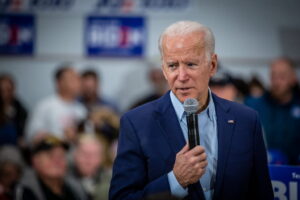
by Alexandra Huzyk ’20
News Staff
The next United States presidential elections are scheduled to take place on Nov. 3, prompting voters to consider a number of diverse candidates. As of January 2020, there are 12 major Democratic candidates, and three major Republican candidates, including incumbent President Donald Trump.
The eighth, ninth, and tenth Democratic primary debates are scheduled to take place throughout February. These debates help to inform voters, promote accountability of elected officials, and progressively narrow down the number of candidates running for the Democratic nomination. Past debates have pressed candidates to address important issues like healthcare, education, gun violence, inequality, and war. The Democratic primary will likely be settled on Super Tuesday—March 3, 2020—“when the largest number of states and territories hold a presidential preference primary or caucus.”
Front-runners for the Democratic nomination currently include Joe Biden, Bernie Sanders, Pete Buttigieg, Elizabeth Warren, and Amy Klobuchar. Many predict Biden will be the nominee for the Democratic Party; having maintained consistently strong African-American support, continuing to receive a multitude of endorsements, and polling the best against President Trump. According to political Analyst Nate Silver, “Should Joe Biden win Iowa, he has an 80 percent chance of becoming the nominee.”
In the wake of these predictions, Sanders has gained momentum within the past months, receiving $34.5 million in the last fundraising quarter and garnering strong support from younger generations and public sector union members. However, Sanders’ democratic socialist views pose an issue for Democrats who think a more politically moderate candidate has a greater chance of winning against President Trump. In addition, many view Sanders’ age (77) and health as potentially problematic.
In the opposing party, candidates who seek to attain the Republican nomination include incumbent President Donald Trump, Joe Walsh, and William F. Weld. Even after having been recently impeached, for abuse of power and obstruction of Congress, President Donald Trump remains the primary Republican presidential candidate. The chances of either Walsh or Weld being granted this nomination are extremely low.
Although presidential approval ratings of Trump have remained notoriously low throughout his time in office, it is reported that he has around a 40% chance of being reelected to office. These chances of reelection may be explained by the decreasing unemployment rate and increasing GDP growth rates, which some attribute to the work of Trump’s presidency.
Historically, 17 of 44 presidents have been reelected for a second term. On the power of incumbency, Aaron David Miller, an academic at the Carnegie Endowment for International Peace, has said, “As President Trump has demonstrated with frightening clarity, presidents dominate the national and media narratives; we see or hear them daily, in Trump’s case often hourly.”
A number of different factors will continue to influence the likelihood of Trump’s reelection, including the upcoming impeachment trial in the Senate and the recently initiated military conflict with Iran.
PC Democrats and Republicans Face-Off in Debate
by The Cowl Editor on November 21, 2019
Campus
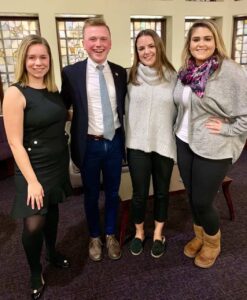
by Alexandra Huzyk ’20
News Staff
On Monday, November 18, 2019, the Providence College Democrats and Republicans hosted a political debate on the topics of healthcare and criminal justice reform. The speakers for the Democrats were Bryan Bates ’20 and Elizabeth McGinn ’21. The speakers representing the Republicans were Krista Minniti ’20 and Katelyn Evans ’23. Professor Joseph Cammarano acted as the facilitator of the debate, posing prewritten questions and moderating when necessary.
After determining that the PC Republicans would begin the debate in a coin toss, the debate began with the question: is healthcare a right? Minniti was first to respond, beginning with, “Nowhere in the Constitution does it mention healthcare as a right…If healthcare was added as a right, doctors would not be paid enough and the ratings of healthcare would decrease because we would not be receiving adequate care.”
In response, McGinn stated that as a member of the Democratic Party she believed that healthcare is in fact a universal right. McGinn cited the recognition of healthcare as a right under the UN Declaration of Human Rights and stated, “We believe that humans should have access to adequate healthcare regardless of race or socioeconomic status.”
McGinn also touched upon the two popular healthcare proposals within the Democratic Party, which are commonly known as “Medicare for all” and an “opt-in system.”
Minniti rebutted this argument by declaring that in the U.S., healthcare is a commodity that can be bought and sold. She then raised the concern of how the government would fund a universal healthcare plan like Medicare for All. Bates responded with: “I invite you to look at Elizabeth Warren’s plan, who worked with economists to…outline specific steps showing where every cent will go in order to provide healthcare to every single American.”
On the same topic of healthcare, another question prompted each party to think about the role of government in combatting the high costs of prescription drugs and medications.
Minniti began by saying that, “President Trump has stated himself that he would like to lower these prices…however, the Senate Republicans have been wary of government intervention. I believe that President Trump must show full support for legislation.” She also advocated for lobbying and the necessity of bipartisan efforts in finding a solution to this issue.
McGinn also commended Trump’s efforts to work towards lowering prescription drug prices, expanding on the fact that, “currently, companies have control of how much to charge.” She also stated that life-saving medicines like EpiPens and insulin should be available to everyone. “If the free market goes unchecked, it will continue to make profit at the expense of human lives.”
Bates also added, “Companies should be allowed to make the money off of the drug that they produced for a little while…but they should not be allowed to sit on patents for so long. Once drugs are put out into the public market, it allows for competition that drives prices down.”
In regards to the criminal justice system, one question was: is the system inherently racist? McGinn said that yes, the criminal justice system is racist. She said that this can be seen in the book The New Jim Crow by Michelle Alexander, and can be traced back to the 13th amendment, which states that slavery is legal within prisons. For these reasons, McGinn stated that people of color are disproportionately affected. This can particularly be seen in the treatment of crimes related to powder and crack cocaine.
“It has been statistically proven that all races use drugs at roughly the same rates, but powder cocaine is largely used by white people in a higher socioeconomic class,” she explained. “For these reasons, laws punish those who possess crack cocaine for a longer period of time; revealing the systematic racism within the criminal justice system.”
In response to these Democratic points, Evans described that oftentimes in the media, there is more of a focus on police brutality rather than crimes committed against police officers. She also offered the statistic that 58.6 percent of federal inmates are white, asking, “If the system was inherently racist, how do you explain these percentages?” Evans also argued that sentencing for crimes have to go through multiple jurisdictions, which would cancel out any racist judgements.
McGinn rebutted these comments by saying that the percentages mentioned by Evans reflect the demographics of the country, for there is a higher number of white people in America. Minniti agreed that the statistics offered were proportionate for the country’s demographics, but claimed that it was the politicians who created the laws that were, perhaps, racist, as opposed to the criminal justice system itself.
Another question on the topic of the criminal justice system was: what are the boundary of rights for felons? McGinn began with an explanation of the discrimination facing felons, including the fact that they do not have a right to vote, and face challenges finding employment, housing, and even health insurance.
Bates argued that “once you have served your time and proven yourself, that you will not go back to prison, you deserve to be considered an American citizen again” and to retain all of the rights that go along with citizenship. In rebuttal, Evans stated that most criminals that are released from prison reoffend and end up incarcerated once again. “What’s the point of felons getting their rights back if they reoffend?” she reflected.
PC Democrats were ultimately determined the winner; however, the event was educational for all. It also serves as a reminder that despite differing political parties or opinions, the importance of respectufl and regulated discussion remains.
Featured Friar: Kyle LaForest-Roys ’20
by The Cowl Editor on November 7, 2019
Campus
by Alexandra Huzyk ’20
News Staff
Kyle LaForest-Roys ’20, a marketing major with an economics minor, has held a number of roles within the Providence College Office of Admissions and Orientation Staff.
LaForest-Roys is one of 12 senior students to become a Senior Admissions Fellow. As a Fellow, LaForest-Roys helps with the recruitment of prospective students, primarily conducting interviews with these students and writing interview summaries afterwards.
LaForest-Roys says, “These interviews are not evaluative, but take into account an overall impression of the student and if Providence College would be a good fit for them. They act as the last point of resource for counselors when they’re evaluating them for admission.”
LaForest-Roys applied to be a Fellow this past spring semester, while he was abroad in Rome, Italy. He shares that he reached out to some of his friends who had previously held this role, as well as some admissions counselors, to learn more about the position itself. After he applied, he was accepted in April.
During the summer, the Fellows completed two weeks of training that informed the students about the specific requirements of the position and how to conduct the interview process.
LaForest-Roys is also an Admissions Ambassador, which is a position that enables current students at the College to connect with prospective students in the admissions process. In this particular role, LaForest-Roys shares that he is able to talk to students, as well as share his story and the information he has on the admissions process itself.
He says, “Having worked as an office assistant in the Admissions Office since my sophomore year, I knew I wanted to become an Admissions Ambassador because I would be able to expand on my more administrative role and be able to share my story.”
As for LaForest-Roys’ story, he shares that it has been about “finding more challenges and people through different opportunities,” whether that be joining clubs like the PC American Marketing Association (AMA) his sophomore year or joining the orientation staff during his junior year. He says, “I want to make an impact on people who maybe want to go to Providence, and then impact those who are already here.”
LaForest-Roys shares that out of the three different positions he holds in Admissions, “The Fellow role is the most engaging, and combines all of the roles together. I’m able to share my experiences and the different challenges that I’ve had to overcome, as well as relate to students who are applying in a more conversational interview setting.”
Besides his multiple roles within the realm of admissions, LaForest-Roys has also been a part of the freshman orientation staff. LaForest-Roys shares that in the fall of his junior year, he was on the operations team. “We were behind the scenes, setting up all of the events, going over the logistics for orientation leaders, and subbing in to groups and sitting in,” he says.
In the following school year, as a senior, LaForest-Roys was an orientation leader. He says, “It was fun to go from operations to being a leader. I got to use all of the training that I had learned and apply it.”
All of these roles have allowed LaForest-Roys to see the intricacies of the entire admissions and enrollment process; from touring, to interviews, to orientation. “Seeing the whole process is kind of cool,” says LaForest-Roys. “Their level of interest often starts with knowing Providence College through a friend or family member, and then they might come in for a serious interview, and then there’s the potential to have them in an orientation group.”
LaForest-Roys shares that the communication skills he has learned within these many roles will transfer into a future career. Upon graduating, LaForest-Roys plans on going into market research and, eventually, attending graduate school to attain an MBA. His dream job is to work for the Boston Red Sox’s marketing department.
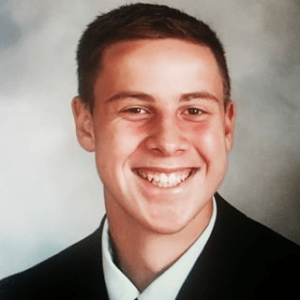
photo courtesy of Kyle Laforest-Roys ’20
Women Making Big Strides in Science: Dr. Amanda Lynch and Ava Calle ’12 Speak at Women in STEM Event
by The Cowl Editor on October 31, 2019
Campus
by Alexandra Huzyk ’20
News Staff
On Wednesday, October 23, Women in STEM hosted their third event, inviting speakers Dr. Amanda Lynch and Ava Calle ’12 to talk about the challenges and opportunities that they have faced pursuing careers within the STEM field.
Lynch, a climate scientist currently teaching at Brown University, obtained a Ph.D. in atmospheric science from the University of Melbourne in 1993. She began as an undergraduate pursuing degrees in electrical engineering and physics, but quickly switched to applied mathematics due to her negative experiences in the realm of laboratory science.
“In engineering and chemistry labs, I didn’t feel welcome, and I was called on to repeatedly demonstrate my competence,” Lynch said. She shared that “having your competence and belonging questioned over and over again, you start to internalize that,” and it is important to remember that “you do belong and you are competent.”
In her presentation, Lynch described data from a 2015 study in which 100% of 60 women scientists had reported encountering one or more patterns of gender bias in the workplace. These experiences were even more pronounced for women of color, who were often questioned whether or not they were supposed to be in labs after hours.
In terms of computational science, Lynch explained, “Women have really been at the forefront of coding, and in fact made up the majority of computer operators, until the ’80s when these numbers plummeted.”
During the 1980s, Lynch explained that people started to think that it was necessary to have knowledge of computers or a love of gaming in high school in order to pursue it in college. “This shift in culture really influenced the uptick of women in science; especially in an area like climate science, which is heavily computational,” said Lynch.
Throughout this change in culture, Lynch continued to code and became the first woman “Scientist 1” at a research center while working towards her Ph.D. However, with this achievement she also became the object of scrutiny. Male supervisors would constantly send female secretaries to check up on her, she received minimal support and guidance, and she was not considered for required computational resources to complete her work. Due to these gender biases, Lynch decided to change Ph.D. programs to another university.
As a climate scientist, Lynch said she started to become involved in field science while she was completing her Ph.D. and then more heavily as a post-doc. “I was very choosy about situations I chose to put myself in,” said Lynch. “I only took positions in which I was the lead researcher… and only with researchers I knew and trusted.” This is due to the issue of sexual harassment and assault in field experiences.
Although Lynch said that she has never personally experienced any form of sexual harassment in this domain of field science, she provided data which reports that harassment affects women more than men in these particular scenarios.
In order to navigate these situations, while pursuing a career in the STEM field, Lynch encouraged the audience to network with both female and male allies. Additionally, she said, “Support other women, refer them, cite them, nominate them. You can do your part, in very concrete ways, whenever you have the opportunity.” Lastly, Lynch stressed the importance of being stubborn and re-submitting proposals and work, especially in the field of academia.
Ava Calle, a Program Specialist and Board Certified Behavior Analyst (BCBA) in the Intensive Instruction Program at The New England Center for Children, presented after Lynch. Calle graduated from Providence College with a BA in psychology and a pre-health minor, and went on to obtain an MS in applied behavior analysis from Western New England University.
She began her presentation by considering the familiar question, “What do you want to be when you grow up?” She pointed out that this question becomes more weighted when you get older and, especially, as you go on to college. Calle said, “It seems like the question might be insinuating how successful you want to be.”
Calle shared that she knew she liked the sciences and people, and would typically answer the question by saying she wanted to go into psychiatric nursing or neuroscience—without actually being convinced of these statements herself.
During her time at PC, Calle conducted research in a cognition lab and completed an internship at the Groden Center. These experiences exposed her to research and design, as well as applied behavioral analysis. Particularly at the Groden Center, Calle was exposed to children with autism, severely challenging behavior, and students who communicated non-verbally.
In her current position at the NECC, for autism education and research, Calle has continued to ask questions as a researcher while also providing direct care as a teacher. She shared that she is still trying to figure out what she wants to be when she grows up, and where her career path will take her. She urged the audience to “think about who you want to be, not just what you want to be when you grow up.”
As for Calle’s suggestions for PC undergraduates, Calle recommended finding a mentor. “There are very strong females in my field. They are researchers and they are mothers and they are wives, and someone has probably been in your position before you.” She also suggested asking for feedback on your performances and always continuingto ask questions.
After both speakers presented, the audience was encouraged to ask questions. One student asked, “For the people in this room who don’t necessarily know what they want to do yet, what would you give them for advice?” Lynch suggested test driving careers, particularly in summer internships or working in a lab with a professor.
Calle said, “Utilize the network and the people in your department, but also other faculty at Providence College and get in touch with alumni. Don’t assume that if their title is X at that point, that they didn’t go through similar situations and jobs.”
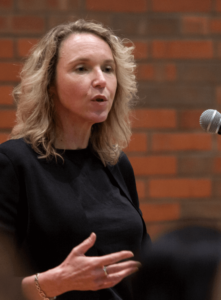
throughout her career.
Nicholas Crenshaw ’20/theCowl
Addressing Mental Health: An Interview with Cheryl Granai
by The Cowl Editor on October 10, 2019
Campus

Photo courtesy of blogs.providence.edu
by Alexandra Huzyk ’20
News Staff
Cheryl Granai, an outreach coordinator at Providence College, spoke about her experiences with helping students who have had mental health issues in the past, and gave advice for the PC community on the best way to handle these situations.
AH: What training do students, or staff, have to recognize mental health scenarios?
CG: We have a couple of ways for students to recognize if someone is in emotional distress. The first is Kognito. It is an online simulation. All of the freshmen, student leaders, and employees are required to take it, but I wish all of our students were required to take it each year. It goes through all of the basic, concerning signs of what would indicate a student experiencing some kind of emotional distress. And then it goes through the right way to have a conversation with that student, because it has to be non-judgmental, validating, and done in a way that does not shut down the student. The third piece of the training is once you have identified that you have a student in crisis, what are your resources on campus and where do you go from there?
The second training we do is called Step-Up Bystander. We do that for all the incoming freshmen, athletes, and Rec sports teams. Step-Up is like Kognito, but the focus is on if you see a student in distress, that you are not necessarily connected to, or if you are in a situation where something seems to be awry but it is unclear. And so this takes you through the process of identifying if this is an issue, bringing others in to validate, and intervening in ways that you still feel safe but you are helping the student. The program is designed so you can talk about any scenario, such as sexual abuse, hazing, relationship problems, mental health issues, substance abuse.
AH: What resources do we have for students on this campus?
CG: We have the Personal Counseling Center, which is wonderful. However, the reality of the situation is that nearly 60 percent of students never step foot in the Center. So the question is, how do you get this information to them? With the PC Lifelines Grant, we’ve been able to do a number of things. One of the things the Grant asks us to do is to identify the students at risk… The College has a Care Team, a group of staff and administrators from all areas, that routinely meets and follows students that have been labeled as ‘at risk.’ And that can be a number of things: a student who has not been showing up for class, is returning from a leave of absence, etc.
We also have implemented some mental health programming to convey information to students about mental health awareness, but we also need to talk about mental illness. And how do you do that in a way that is not threatening for a student? So what we have done is looked for speakers with ‘lived experience,’ and that means we want to bring speakers in that students can identify with. These are speakers that have had mental illness, who have lived through it, who have come out the other end, that have developed a mental health regime with positive coping skills… and it is really a story of personal resilience. We have had three speakers like that, and we are bringing another in for Mental Health Awareness Month on Oct. 22.
The other thing we do is we provide resources for students who left campus for mental health reasons. So, a leave of absence in general is disruptive, but, you add that component of mental illness and then it becomes scary. So we developed protocol to follow these students the whole time they are on a leave. It takes the form of email, text, or sometimes in person meetings.
Oftentimes students do not respond, but research shows that just simply reaching out with a concerned message improves the mental health of the student. And then what we do when they come back, which can be just as disruptive, we meet in person once or twice a month to build resilience skills and to develop a new narrative of who they are.
We also developed a resilience case model, that is built on resilience coaching. Students can self-refer, and come to three to five sessions and work on these skills. The last piece is just happening now, and stems from a 2001 grad from PC who struggled with anxiety and depression. He felt like there were not any resources for him on campus. So he goes off to graduate school and founds a company, and comes back to PC last year offering grant money to help students deal with anxiety and depression. So we started this academic resilience fellowship, and asked faculty from around the campus if they would participate. And what we are asking is for them to incorporate resilience building skills into coursework.
AH: How would you differentiate being sad versus being depressed?
CG: There is sadness, and occasional depression, that happens in everybody’s life. But if this sadness persists, if you start to isolate yourself, if you stop caring for yourself, if your sleep changes, if you are abusing substances more than you normally do, if you are starting to have thoughts of suicide or ‘I don’t want to do this anymore,’ then that is depression. That is the difference between having a blue day and having something happen to me that is consistent and changing the way I behave and think.
AH: For students on the fence, deciding whether or not to go to the Counseling Center, what would you say to them?
CG: I do not think counseling would do any harm even if there was absolutely nothing wrong with you. There is no harm in that, and just have a conversation. And many times, a student will go to a counselor and go once a semester—maybe three times. It doesn’t have to be an ongoing, weekly occurrence. It can be a one-stop shopping, like I need to know if what I’m thinking and feeling is normal and to give me some tools to deal with whatever is coming up, whether that be anxiety, stress…
AH: For freshmen, or any class, who have a roommate who needs help but doesn’t want to get any; what suggestions do you have?
CG: If you’re concerned with a student and they are not willing to get help for themselves, and you have tried having these conversations with them, I think that the best thing to do is go to a trusted adult. Go to them and say: ‘Look, this is what I am seeing, this is how the student is responding, what do you think I should do?’ The RA’s are a way to go as well, but I do think that it helps to get that sort of validation from someone who is older and that they can trust. Either way is not bad, but you don’t want to hold onto this yourself and just hope for the best.
Then there is a situation where a student you’re dealing with reveals to you that they have had thoughts of either suicide or harming themselves or they do not want to be here anymore. In that situation, we advise students to stay with the person and get help from the outside however they can—text or call for help. Because when you hear those things, you don’t want to leave the student alone. Some people call an RA, Public Safety, Personal Counseling… If you are hearing something that is specifically about a plan, and it is 3 a.m., you want to text or call Public Safety. Explain to them what is happening and that you do not want to leave the student alone. These are really scary conversations, for everybody. But these types of crises are short lived and they pass. The best thing to do, if you are worried about any kind of suicidal plan or follow through, is to not leave the student.
Bursting the PC Bubble: “Whistleblower” Scandal Leads to Impeachment Trial
by The Cowl Editor on October 3, 2019
National and Global News
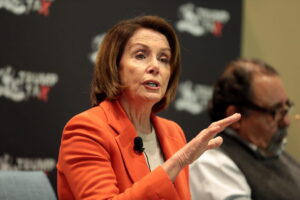
by Alexandra Huzyk ’20
News Staff
On Tuesday, September 24, Speaker of the House Nancy Pelosi ordered an impeachment inquiry on President Trump. The order was prompted by a phone call that occurred between Trump and the Ukranian president, Volodymyr Zelensky. In this phone call, Zelensky reportedly asked for missiles, and Trump, in turn, asked for an investigation of Joe Biden and his son, Hunter Biden.
The call was initially reported by a U.S. intelligence official as a whistleblower complaint. He or she claims: “I have received information from multiple U.S. government officials that the President of the United States is using the power of his office to solicit interference from a foreign country in the 2020 U.S. election.” The whistleblower claims that he or she was told the transcript of this particular call was transferred to a separate electronic system, for highly sensitive classified information.
Democrat Adam Schiff, chairman of the House Intelligence Committee, is in charge of leading this investigation and has confirmed that the whistleblower, who remains unnamed for safety reasons, will testify in the future.
Schiff says that Rudy Giuliani, Trump’s personal lawyer, will be summoned, as he has previously encouraged Ukraine to investigate both Hillary Clinton and Joe Biden.
Giuliani had reportedly asked Ukraine to examine Hunter Biden, due to his involvement with a Ukrainian company that was under investigation. At the time, no evidence of illegal activity surfaced. However, later in the Obama Administration, Vice President Biden was involved in firing the Ukrainian prosecutor general.
In the White House transcripts of President Trump’s call to Zelensky, released on Wednesday, Sept. 25, Trump is recorded as having specifically asked if this matter could be further investigated.
Upon being asked if he was pressured into conducting this favor, Zelensky says that he was not coerced into anything. However, investigators believe that pressure from the White House began months before the call occurred.
Not only had Vice President Mike Pence canceled plans to attend Zelensky’s inauguration, but Trump had suspended $400 million of aid that was approved to go to Ukraine.
Kevin McCarthy, leader of the House of Republicans and head of House efforts against impeachment, claims that Trump has done nothing illegal or worthy of impeachment. He believes that none of Trump’s actions rise to the level of high crimes and misdemeanors that justify discussion of impeachment.
In contrast, Pelosi says that it is not just the call between Trump and Zelensky that should be considered; it is the sequencing of events that should inform the President’s actions.
Since Pelosi’s order, the Trump campaign has focused on social media and fundraising messaging. One message that has taken shape is the portrayal of Democrats as willing to sacrifice all matters of domestic policy, such as gun rights and healthcare, for the sake of Trump’s impeachment.
More than half of Americans, including a large majority of Democrats, approve of the impeachment inquiry. Having previously been accused of collusion with Russia in the Mueller investigation, many Democrats feel that Trump’s involvement with Ukraine is not only illegal but also deserving of impeachment.
On the other hand, many Republicans do not deem Trump’s actions illegal or different than any other actions of past presidents. This partisan divide is emblematic of the larger divide over whether or not Trump is deserving of impeachment.
In the upcoming weeks, House Democrats will conduct investigations through separate committees and submit their information to the House Judiciary Committee—traditionally known for dealing with formal matters of impeachment. This committee must first approve all evidence before the House votes.
With Democrats holding the majority of seats in the House, it is predicted that the majority of House members will vote for the impeachment of Trump. If this occurs, Chief Justice John Roberts will conduct a televised trial in which all 100 members of the upper chamber of the Senate would serve as the jury.
As Republicans control the Senate, they would hold a central role in determining the ruling of the trial.
CampusWell Provides Mental Health Support for Students
by The Cowl Editor on September 26, 2019
Campus

By Alexandra Huzyk ’20
News Staff
Cheryl Granai, coordinator of outreach and prevention, is working with students and other administrators to increase student readership for Student Health 101, recently renamed CampusWell. This company provides relevant, weekly content about wellness and mental health that is specifically tailored to college students.
Granai explains that the company delivers the online magazine through email. Undergraduate students—as well as continuing education and graduate students, faculty, and parents—receive these emails containing updates about the magazine and giveaways being held by CampusWell. At this time, CampusWell can only be sent to student emails, but Granai hopes to expand the reach of this content further in the future.
The company itself offers ways to market content on social media, which Granai hopes to put into practice. “We’re thinking that we’re not reaching enough students, and so we are looking to bring more social media tools into the equation,” says Granai.
She shares that she hopes to advertise on Instagram at least once a week, and on Facebook once a month to maximize the ways in which students use social media. In addition to these social media strategies, Granai also hopes to advertise for CampusWell by printing ads within The Cowl.
Granai says, “The push is to get more visibility of the magazine and to get students more involved. We hope to have students publish their own work, in order to make the content more individualized to Providence College.”
Besides increasing student involvement, Granai also says that she would like to see more faculty incorporate the content created by CampusWell into their curriculum, or encourage it to be used as a resource for students.
As a certified mental health counselor, one of Granai’s roles at the College is to focus on psychoeducation, outreach, and prevention. Part of her focus is to examine what the College is doing to help students cope with prevalent mental health challenges.
“The current generation is very anxious. They’re not in crisis but they are still dealing with anxiety. We’re never going to be able to completely take away that anxiety, so we must teach students how to manage a healthy relationship with it,” shares Granai.
In order to help with these common struggles, Granai hopes that the content provided by CampusWell will help to serve as useful practices that students can implement into their daily lives.
Besides offering tips on how to manage stress and anxiety, Granai hopes that CampusWell will aid in the larger fight to destigmatize the topic of mental health. Granai says, “There’s no difference between a head illness and a bone illness. In both cases, your body is telling you that something is up. So the question becomes: how do we destigmatize mental health, and how do we make it into a conversation instead of a taboo?”
In the future, Granai says to be on the lookout for posters and fliers that will provide information on upcoming events having to do with mental health awareness. Students within various clubs and organizations on campus will also be wearing shirts promoting the events.
If you are a student or faculty member who is interested in learning more about CampusWell, or creating content, contact Cheryl Granai (cgranai@providence.edu) or Morgan Tullar (mtullar@providence.edu).
